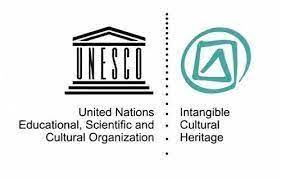09 Jul 2022 Intangible Cultural Heritage: UNESCO

- India has been elected to the Inter-Governmental Committee of UNESCO’s 2003 Convention for the Protection of Intangible Cultural Heritage (ICH) for the period 2022-2026.
- India has served as a member of the ICH committee twice, from 2006 to 2010 and 2014 to 2018.
- Earlier, Durga Puja in Kolkata was inscribed in UNESCO’s representative list of Intangible Cultural Heritage of Humanity (ICH).
Intangible cultural Heritage:
- Intangible cultural heritage is the practices, expressions, knowledge and skills that communities, groups and sometimes individuals recognize as part of their cultural heritage.
- Also called living cultural heritage, it is usually expressed in one of the following forms:
- Oral traditions
- Performing Arts
- Social Practices
- Rituals and Festive Programs
- Knowledge and practice related to nature and the universe
- Traditional Craftsmanship
Importance of India being elected to the convention:
- It will help India to promote community participation, strengthen international cooperation through intangible heritage, promote academic research on intangible cultural heritage and align the work of the Convention with the United Nations Sustainable Development Goals.
- India will have the opportunity to closely monitor the implementation of the 2003 Convention.
- India will endeavor to encourage intra-state international dialogue for the Convention to appropriately reflect the diversity and importance of living heritage.
UNESCO’s Convention for the Protection of Intangible Heritage:
- The Convention on the Protection of the Intangible Cultural Heritage was adopted by the United Nations Educational, Scientific and Cultural Organization (UNESCO) in 2003 and entered into force in 2006.
- It consists of 24 members and is elected by the General Assembly of the Convention according to the principles of equal geographical representation and rotation.
- The members of the committee are elected for a term of four years.
Purpose:
- To protect the manifestations of intangible cultural heritage threatened by the processes of globalization.
- Ensuring respect for the intangible cultural heritage of communities, groups and individuals.
- Raising awareness of the importance of intangible cultural heritage at the local, national and international level.
Publications:
- Representative List of the Intangible Cultural Heritage of Humanity.
- List of intangible cultural heritage in need of immediate protection.
- Register of Good Security Practices
Recognized Indian Heritage as ICH:
- ICH’s prestigious UNESCO Representative List of Humanity includes 14 Intangible Cultural Heritage of India
- Apart from Durga Puja, there are 13 traditions recognized by UNESCO as ICH in India.


No Comments